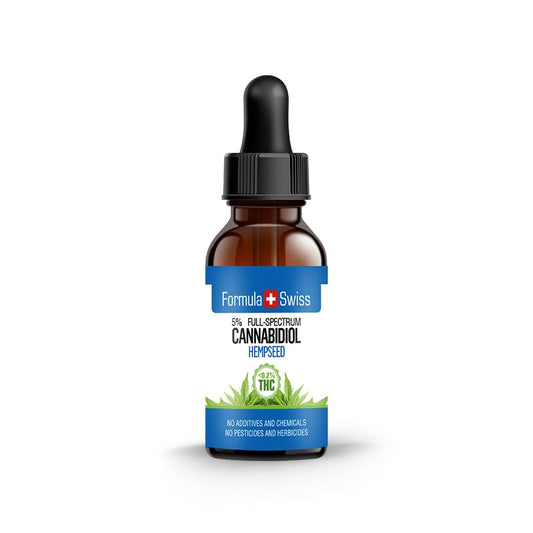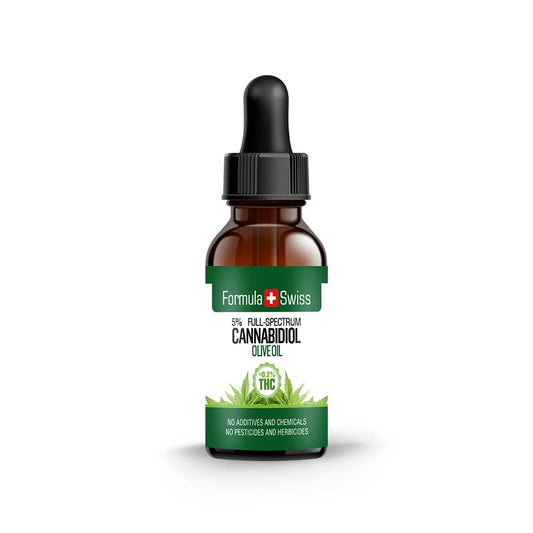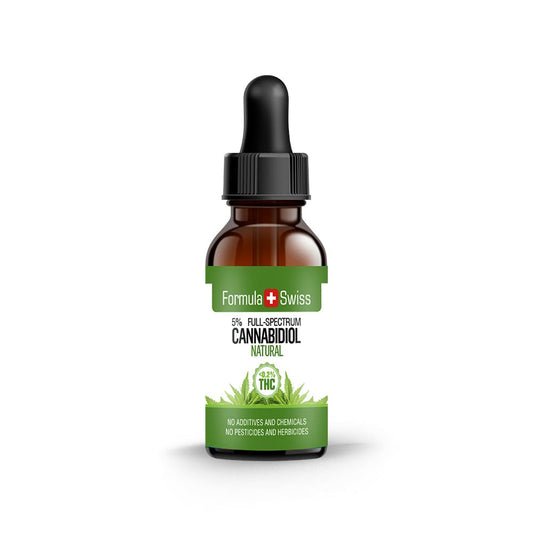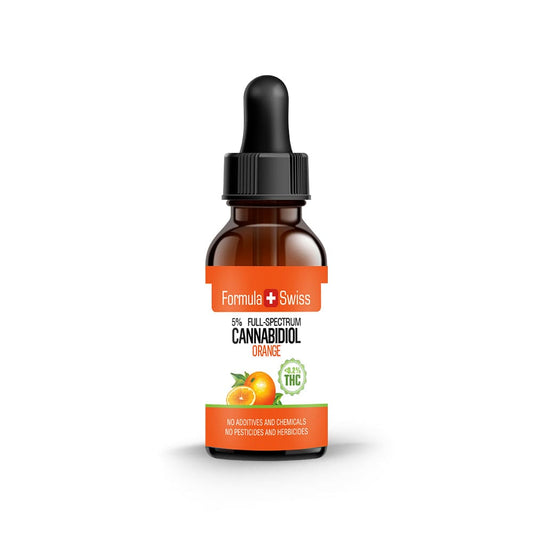CBG, short for Cannabigerol, is gaining increasing attention in cannabinoid research for its unique role within the cannabis plant. Unlike THC, CBG is non-intoxicating and does not produce psychoactive effects, making it a subject of interest for those exploring cannabinoids with different characteristics.
Often referred to as the "mother cannabinoid", CBG serves as the chemical precursor from which other cannabinoids, including CBD and THC, are synthesised as the plant matures. At Formula Swiss, we closely follow developments in cannabinoid science to provide accurate and well-researched information.
Building on the foundational work of researchers such as Gaoni and Mechoulam, recent studies continue to explore CBG’s profile and its relevance within both scientific and consumer contexts.
In my experience following cannabinoid research, CBG plays a key role in the early stages of cannabinoid development within the cannabis plant.
It acts as a starting point for the formation of other compounds like CBD and THC, making it a relevant area of study. Clear information about CBG helps support accurate understanding in a field that continues to evolve.
Key takeaways
- CBG, or Cannabigerol, is a non-psychoactive cannabinoid found in hemp and cannabis plants.
- Identified by researchers Gaoni and Mechoulam, CBG is considered the precursor to other cannabinoids, such as THC and CBD.
- CBG oil has gained traction as a natural supplement, offering potential health benefits.
- Unlike THC, CBG is non-intoxicating, making it more appealing for therapeutic applications.
- Research into the potential benefits and applications of CBG is ongoing and expanding.
This article is provided for informational purposes only and does not relate to any of the products available in our webshop. For more information, please see our full disclaimer.
A brief history of cannabigerol
The history of cannabigerol, or CBG, is closely tied to the early days of cannabinoid research and the work of two pioneering Israeli chemists, Yehiel Gaoni and Raphael Mechoulam. In the 1960s, their investigations into the chemical makeup of the cannabis plant led to the identification and isolation of CBG—an important milestone that helped open the door to a deeper understanding of cannabinoids and their development.
CBG was later recognised as the precursor molecule from which other well-known cannabinoids, including THC and CBD, are synthesised during the plant’s growth. This unique role in the biosynthesis process has earned CBG the informal title “the mother of all cannabinoids.”
As scientific interest in cannabis expanded, researchers continued to explore the chemical pathways and biological roles of CBG. While much remains under investigation, CBG’s structural and functional position within the plant has made it a key point of reference in cannabinoid research.
The foundational work of Gaoni and Mechoulam remains central to how CBG is understood today. Their early contributions provided a basis for further study into the cannabis plant’s complex composition and the processes by which cannabinoids are formed.
 What makes cannabigerol (CBG) distinct
What makes cannabigerol (CBG) distinct
Cannabigerol (CBG) stands out among the many naturally occurring cannabinoids in the cannabis plant due to its central role as a precursor to other well-known compounds, including THC and CBD. This section outlines what distinguishes CBG and explains how it is formed and extracted.
CBG originates from a compound known as cannabigerolic acid (CBGA), which appears in higher concentrations in younger cannabis plants. As the plant matures, CBGA is converted by natural enzymatic processes into other cannabinoid acids—specifically, THCA and CBDA—which eventually become THC and CBD when heated or processed.
Because most CBGA is converted into other cannabinoids during plant growth, only small amounts of CBG remain in mature plants, making its extraction more complex and often requiring selective breeding or harvesting at earlier stages.
CBG is non-psychoactive and does not produce intoxicating effects. From what I’ve observed, this has contributed to its appeal in both scientific and commercial contexts, particularly where there is interest in compounds that interact with the body’s natural systems without producing a “high.”
In recent years, high-CBG hemp strains have been developed to support ongoing research and further study of its distinct properties.
The process of CBG extraction
Extracting CBG typically involves isolating the compound from young cannabis plants, which contain higher levels of its acidic precursor, cannabigerolic acid (CBGA). As the plant matures, CBGA is largely converted into other cannabinoids, making early harvesting key to obtaining usable amounts of CBG.
One widely used method for refining CBG from plant material is chromatographic separation, a technique noted in research by Citti et al. and Wang et al. Other common methods include CO₂ extraction, which is valued for its ability to preserve cannabinoid integrity without leaving solvent residues.
| Step | Description |
|---|---|
| 1. Harvesting | Young cannabis plants with higher CBGA levels are selected to maximise CBG content. |
| 2. Decarboxylation | CBGA is converted into CBG through controlled heating, releasing carbon dioxide. |
| 3. Extraction | CBG is separated from the plant material using methods such as CO₂ extraction or chromatography. |
| 4. Purification & isolation | Unwanted compounds are removed, and the extract is refined to isolate CBG. |
| 5. Final product | The isolated CBG can then be used in a range of cannabinoid-based product formulations. |
The chemical structure of CBG
The molecular structure of Cannabigerol (CBG) plays a crucial role in its interactions with the human body's endocannabinoid system.

Over the years, researchers have examined the molecular composition of CBG, offering valuable insights into its structure and how it may interact with various receptors in the body.
Key developments in cannabinoid chemistry were made by researchers such as Hanuš et al., who successfully mapped the molecular configuration of CBG. Their work has contributed to a broader understanding of how CBG may engage with both cannabinoid and non-cannabinoid receptors.
“CBG is the non-acidic form of cannabigerolic acid (CBGA), which serves as the parent molecule from which other cannabinoids are synthesised.” — Hanuš et al.
These molecular characteristics can be further explored by examining the chemical structure of CBG. Its molecular formula is C₂₁H₃₂O₂. While it shares structural similarities with other cannabinoids such as CBD and THC, it also displays important differences that influence its behaviour.
Prefer watching over reading? This video covers the key points from the article:
Key structural features of CBG include
- Molecular composition: CBG contains a cyclohexene ring, whereas CBD contains a benzene ring
- Double bond configuration: The positioning of the double bond in the cyclohexene ring differs between CBG and THC
- Functional groups: Variations in the functional groups contribute to CBG’s distinct characteristics compared to other cannabinoids
As noted by Pertwee and collaborators, the specific molecular composition of Cannabigerol has contributed to ongoing research into its interactions within biological systems.
CBG compared to other cannabinoids
When comparing cannabinoids, much attention is often given to the distinctions between CBG, CBD, and THC. While all three are derived from the cannabis plant, their chemical structures and interactions with the body’s natural systems distinguish them from one another.
This section outlines the key similarities and differences between these cannabinoids.
| Cannabinoid | Chemical structure | Psychoactive properties | Affinity for cannabinoid receptors | Potential clinical applications |
|---|---|---|---|---|
| CBG (Cannabigerol) | Unique precursor structure | Non-psychoactive | Low affinity for CB1 and CB2 receptors | Studied for various biological interactions |
| CBD (Cannabidiol) | Similar to CBG with molecular differences | Non-psychoactive | Low affinity for CB1 and CB2 receptors | Studied for a range of physiological processes |
| THC (Tetrahydrocannabinol) | Distinct from CBG and CBD | Psychoactive | High affinity for CB1 and moderate affinity for CB2 receptors | Known for its psychoactive effects and studied for multiple applications |
While THC is known for producing psychoactive effects, both CBG and CBD are non-psychoactive and do not cause intoxication. However, they differ in how they interact with cannabinoid receptors, which can influence their observed biological activity.
Research by Navarro et al. and Cascio et al. has demonstrated that CBG and CBD engage differently with these receptors, reflecting their unique characteristics within the broader cannabinoid profile.
"CBG and CBD are both non-psychoactive; however, they differ in their affinity for cannabinoid receptors."
In my experience following cannabinoid research, understanding these distinctions is important for advancing scientific discussions and supporting informed decision-making.
As research continues, recognising both the differences and commonalities among cannabinoids like CBG, CBD, and THC contributes to a more complete understanding of their roles in cannabis science.
Scientific interest in the potential of CBG
Recent research has increased interest in how CBG may interact with biological systems, sparking curiosity within the scientific community. While definitive conclusions have not yet been established, preliminary studies have begun to explore CBG’s characteristics and potential biological activities.
Italian researcher Francesca Borrelli and colleagues conducted a study indicating that CBG showed promising anti-inflammatory activity in preclinical models. Their findings, based on studies in mice, suggested that CBG could influence inflammatory responses in experimental settings.
Additionally, Spanish researcher Xavier Nadal and his team examined how CBG affected neuroinflammation and oxidative stress in a mouse model of experimental autoimmune encephalomyelitis. Their research reported reductions in certain markers linked to inflammation and stress responses, contributing to further interest in CBG’s biological interactions.
Although these early studies are encouraging, most of the current data comes from laboratory or animal models. More comprehensive research, including human studies, is required to determine how these findings may translate to broader contexts. Areas of ongoing investigation include:
- Glaucoma
- Inflammatory responses
- Neurodegenerative processes
- Antimicrobial properties
- Oncology-related research
In my experience following cannabinoid research, the expanding body of CBG studies highlights the importance of continued exploration while maintaining careful scientific evaluation. Individuals considering cannabinoid products are encouraged to stay informed and consult healthcare professionals regarding any use in personal routines.
Current research on Cannabigerol (CBG)
Scientific investigations into cannabigerol (CBG) have increasingly concentrated on its pharmacokinetics, its role in the endocannabinoid system, and the molecular mechanisms by which it may influence biological processes. Contemporary studies have explored CBG’s activity across various cell lines, receptor types, and cellular pathways, contributing to a broader understanding of its pharmacological profile.
Emerging research, including findings from Waldstein et al. (2020), highlights a number of scientifically relevant observations that warrant further exploration through well-designed experimental studies. These findings are preliminary in nature and are not indicative of clinical outcomes.
CBG is currently under investigation in various areas of cannabinoid science, including:
- Mechanisms related to inflammatory signalling pathways
- Modulation of oxidative stress and redox balance
- Interactions within neuronal systems
- Studies of antibacterial activity in vitro
Researchers continue to examine CBG in relation to receptor interactions, particularly involving CB1, CB2, and other molecular targets associated with homeostatic regulation. This expanding body of literature is crucial for understanding the functional characteristics of CBG within the broader context of cannabinoid research.
Receptor interaction and research insights
Studies show that CBG binds weakly to CB1 and CB2 receptors, but is a strong activator of TRPV1 channels, more so than other phytocannabinoids. It also appears to modulate the 5-HT1A receptor, which is involved in key regulatory functions.
Further research has explored CBG’s relevance in models involving neurodegeneration, antibacterial activity, and intraocular pressure. These findings are preliminary and require further investigation.
CBG in dermatological and inflammatory research
Another study titled "In Vitro and Clinical Evaluation of Cannabigerol (CBG) Produced via Yeast Biosynthesis" discusses CBG's broad range of anti-inflammatory properties and benefits for skin health.
This research highlights CBG’s relevance in ongoing studies related to skincare applications and inflammatory pathways.
CBG in consumer products
With increasing interest in cannabigerol (CBG), a growing range of CBG-infused products has become available in the consumer market. This section outlines the various product categories and offers general guidance for evaluating quality and transparency in CBG offerings.
Types of CBG products in the market
CBG is available in a range of product formats designed to suit various consumer preferences. Common types of consumer-grade CBG products include:
- Topical applications (e.g., creams and balms)
- Patches
- Cosmetic formulations
- Formulated oils for external use
These products are available in a range of concentrations and formulations, providing options that can be incorporated into individual skincare and personal care routines. As interest in cannabinoids grows, manufacturers are continually developing new products and refining existing lines to meet changing market preferences and consumer demands.
Choosing high-quality CBG products
In an evolving market where standards can vary, maintaining the quality and authenticity of CBG products is of utmost importance. To help make well-informed choices, it is useful to keep the following key considerations in mind when assessing CBG products:
- Third-party laboratory testing: Reliable products are typically accompanied by independent lab test results, verifying details such as cannabinoid content and the absence of contaminants.
- Certificates of analysis (COAs): A COA outlines the cannabinoid profile of a product and may include test results for pesticides, heavy metals, and microbial content. At Formula Swiss, we make all COAs readily accessible on our website to ensure full transparency and product traceability.
- Source and cultivation standards: The origin of the raw material—particularly organically cultivated hemp—can significantly impact product quality. Hemp grown under controlled, regulated agricultural practices is generally more consistent and traceable.
- Extraction techniques: The method used to extract CBG matters. CO₂ extraction is widely recognised for its ability to produce high-purity extracts without the use of harsh chemical solvents.
By reviewing these criteria and researching reputable sources, consumers can better navigate the CBG product landscape and choose offerings that meet high standards for quality, safety, and transparency.
Using CBG in your routine
CBG can be incorporated into daily routines through various non-ingestible formats such as topicals, patches, cosmetic products, and formulated oils for external use. These options offer flexibility depending on individual preferences and needs.
It is advisable to begin with minimal application and observe the response when trying a new product. As research and innovation continue, CBG products are expected to become more tailored and accessible.
How much CBG oil should I use?
The future of CBG
Advances in research and technology continue to shape the future of cannabigerol (CBG). Innovations in extraction methods and synthetic biosynthesis are improving production efficiency and expanding accessibility.
Studies by Taura et al. and Gagne et al. highlight techniques aimed at enhancing the sustainability and scalability of CBG production, supporting both scientific exploration and product development.
These developments are expected to influence the CBG market by enabling broader availability and stimulating innovation in cannabinoid-based formulations.

Recent developments in CBG extraction technology and cannabinoid biosynthesis have optimized the production process, reducing costs and increasing the availability of this valuable compound.
Researchers like Taura et al. and Gagne et al. have explored innovative techniques to improve the extraction and synthesis of CBG, leading to a more sustainable and cost-effective supply chain for both medical research and consumer products.
"Innovative methods in CBG extraction and synthesis are driving a more efficient production process, making CBG more accessible to consumers and researchers alike."
These innovations are expected to reshape the CBG landscape, ultimately leading to enhanced product offerings and increased demand for this emerging cannabinoid.
Personal perspective
Following cannabinoid research closely at Formula Swiss, CBG stands out as a particularly intriguing compound. Unlike many of the more widely known cannabinoids, CBG has a foundational role in the plant’s chemical development, which makes it especially interesting from a scientific perspective. Seeing how this compound transforms into others like CBD and THC adds a unique layer to our understanding of the plant as a whole.
What I find most compelling is how much attention CBG is beginning to receive in academic and research settings. As more is uncovered about its interactions with various receptor systems, it becomes clear that CBG offers a distinct profile worth studying in its own right. Staying informed through reliable, research-based sources is essential as the conversation around cannabinoids continues to evolve.
Frequently asked questions
What is CBG?
CBG, or Cannabigerol, is a non-psychotomimetic cannabinoid found in the Cannabis sativa plant. It is known as a precursor compound that leads to the formation of other cannabinoids such as CBD and THC during the plant’s growth cycle.
How is CBG produced in the cannabis plant?
CBG originates in the plant as cannabigerolic acid (CBGA), an early-stage compound. As the plant matures, CBGA is naturally converted into other cannabinoid acids. When exposed to heat, CBGA can transform into CBG through a process known as decarboxylation.
How does CBG interact with the body?
Research indicates that CBG can interact with various receptor systems in the body, including cannabinoid receptors (CB1 and CB2), as well as other biological targets such as TRP channels and serotonin-related pathways. This remains an area of active scientific investigation.
What are scientists studying about CBG?
Studies are ongoing to explore CBG’s properties and its interaction with different biological systems. While early research is of interest to scientists, no definitive conclusions have been reached, and further investigation is needed to understand its full profile.
How does CBG compare to other cannabinoids?
CBG differs structurally from CBD and THC and is considered to have distinct interactions with receptor sites in the body. Unlike THC, it does not produce psychotropic effects. Its role as a foundational cannabinoid has attracted increasing attention in cannabinoid research.
To better understand where CBG comes from, you may be interested in what CBGA (Cannabigerolic acid) is and how it contributes to cannabinoid development.






